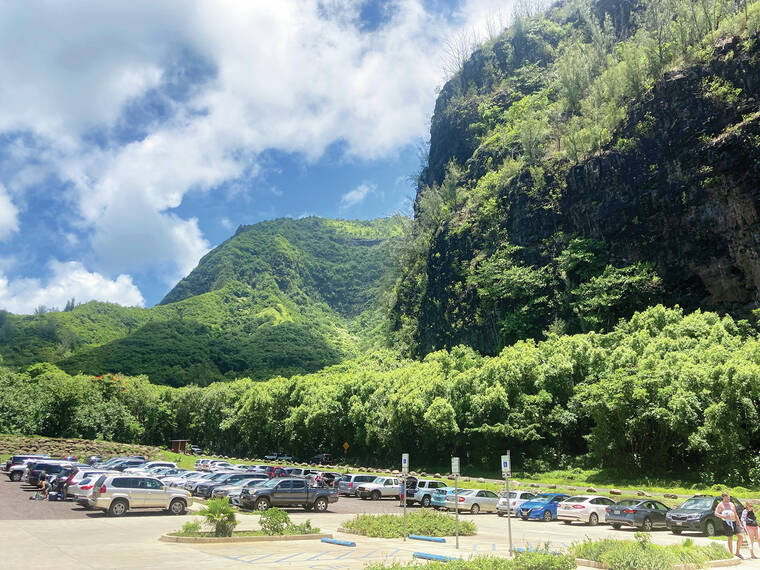HA‘ENA — A natural disaster and a pandemic forced the issue, and now Hawai‘i is at the forefront of regenerative tourism, the re-imagining of tourism and adaptive management, according to the state Department of Land and Natural Resources.
At Ha‘ena State Park on the North Shore, adaptive management kicked into high gear after the historic 2018 floods which closed much of the North Shore for a year and a half.
The DLNR Division of State Parks accelerated the implementation of the park’s master plan and used a pause in visitation to redesign and rebuild the parking lot; to build upon strong engagement with the community and lineal descendants of the area; and to evolve partnerships with others, like the Hui Maka‘ainana o Makana, which is now handling reservations and parking and a shuttle service to and from the park.
“It shows we can be innovative and not only reduce the impacts of visitors to our resources, neighbors and rural communities, but also to empower them to help us in the management,” DSP Administrator Curt Cottrell said. “We know the state can’t do it alone, and we must engage and collaborate with community partners.”
Ha‘ena, the gateway to the Napali Coast State Wilderness Park, now is able, through reservation and parking controls, to cap daily visitation to both parks at 900 people, compared to 2,000 or more before the flood.
“There is no one recipe on how to best manage sensitive cultural and natural resources and a fluctuating visitor industry,” Cottrell said. “(There are) a lot of moving parts to work with, and that’s the adaptation part. We often don’t know how something is going to work until we launch it, and we are learning it requires monitoring and adjusting.”
The visitor industry has fluctuated since early 2020. This provided additional opportunities to tweak, to discover, to rebuild and to reimagine tourism. A key component was the institution of a pay-to-play paradigm.
“During the COVID-19 pandemic we did a fee increase for parking, entry, camping and lodging” at state parks, he said. “Our fees went up to be in alignment with fees at other state parks units in the U.S. We can now generate more revenue with fewer visitors to put back into our parks,” Cottrell said.
In Ha‘ena, the DLNR expanded a partnership with Hui Maka‘ainana o Makana, which is a component of the master plan. “We wanted to migrate more into community-based management of visitors, as they know what they can handle. The hui had already been restoring the lo‘i kalo (taro) system in the park for more than two decades, and with the
number of lineal descendants involved, this type of adaptive management makes perfect sense.”
The DSP is exploring more community management partnerships at places like Kealakekua Bay State Historical Park on Hawai‘i Island.
“It’s precedent-setting because some of the funds generated through this integrated shuttle, parking and entry system will stay here in the park,” said Chipper Wichman, life-long North Shore resident and one of the founding directors of the hui. “To create community-based, culturally grounded jobs for our community to take care of this area is so important.”
The reopening of Ha‘ena State Park in 2019 was heralded as a “new day.”
Wichman, who is also president of the National Tropical Botanical Garden, said, “It’s really regenerative tourism. You hear that buzzword a lot, but here the rubber is meeting the road. Seeing some of the money generated stay in Ha‘ena to create jobs and care for the natural and cultural resources has been our dream for over 30 years, and now it is finally happening.”
Well-known travel writers and broadcasters have visited Kaua‘i in recent months to chronicle regenerative tourism at Ha‘ena.
PBS is planning a segment for its “Travel Detective” program hosted by tourism journalist Peter Greenberg. Focusing on hidden gems, Greenberg and his production team visited the park in June.
“It’s a great idea because the community is involved. It’s about educating local folks and visitors. The concept of, ‘we want more visitors, we want them spending more, we want longer stays,’ no longer works,” Greenberg said.




All they did by this was displace tourists into other areas. Now tourists are going to dangerous beaches with NO lifeguards and NO bathrooms. Ke’e is practically empty. Many end up at Lumadie. Tell me how that is good. All other beach communities are suffering overcrowding as a result of shutting Ke’e. It just goes to show how out of touch these permapoliticians are with the real community. Let’s get some fresh blood in there.
Do as those residents and Maka’aina O’ Makana Hui did work to control the overuse of your beaches and cultural sites. Help also to educate the tourists and locals using your area it is your KULEANA.
Wow. I would not like to have been in the shoes for all this change. I know it is needed. I can tell just by small hiking trails are worn down. Something had to be done. I am sooooo very glad that I lived on Kauai during the 70’s and have the memories of just pulling up in a dirt lot of about 4 other cars and enjoying the beach and kalau trail. I dont understand why people dont enjoy Kee beach now. I sure would if I was there especially now knowing it is empty most of the time. I do hear other locals mention that this is really not true, that the Kee beach is crowded and some may be even camping there. In any case. I hate that everything has to be monitored and charged for, but I understand it is best for the environment and control of over crowding. All i can say is people, think about your sex life and why you are having children. Over population is going to ruin the islands!